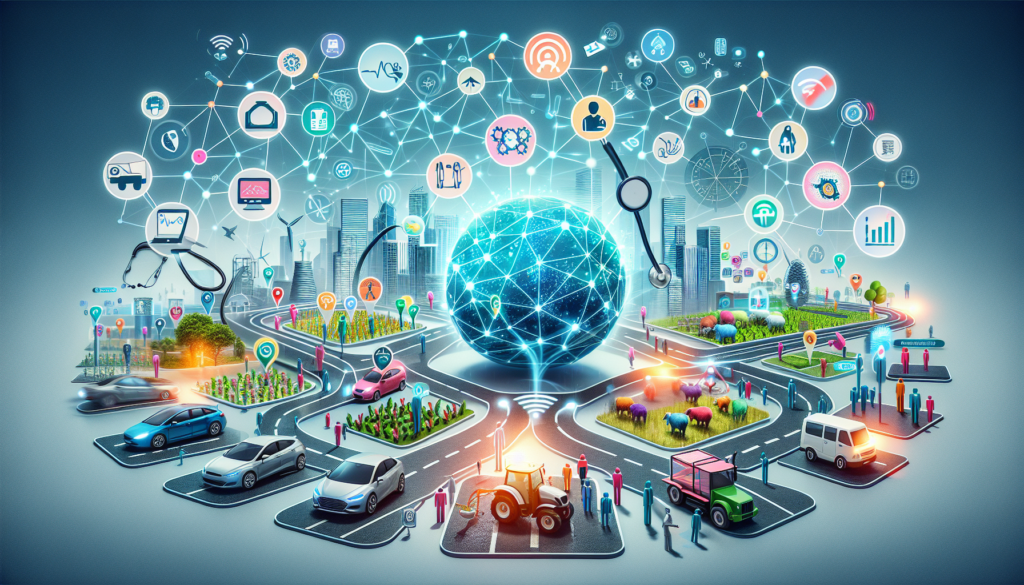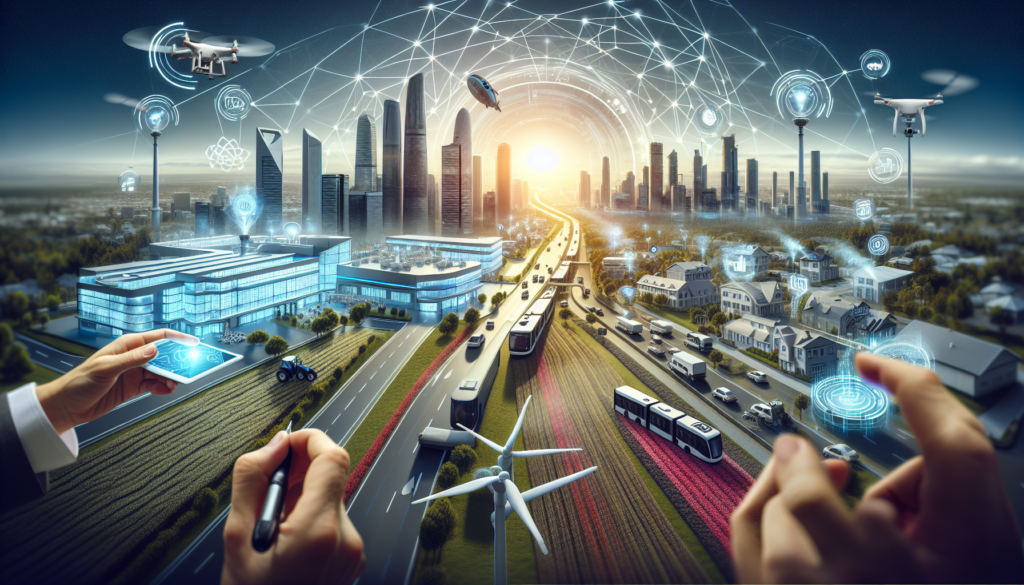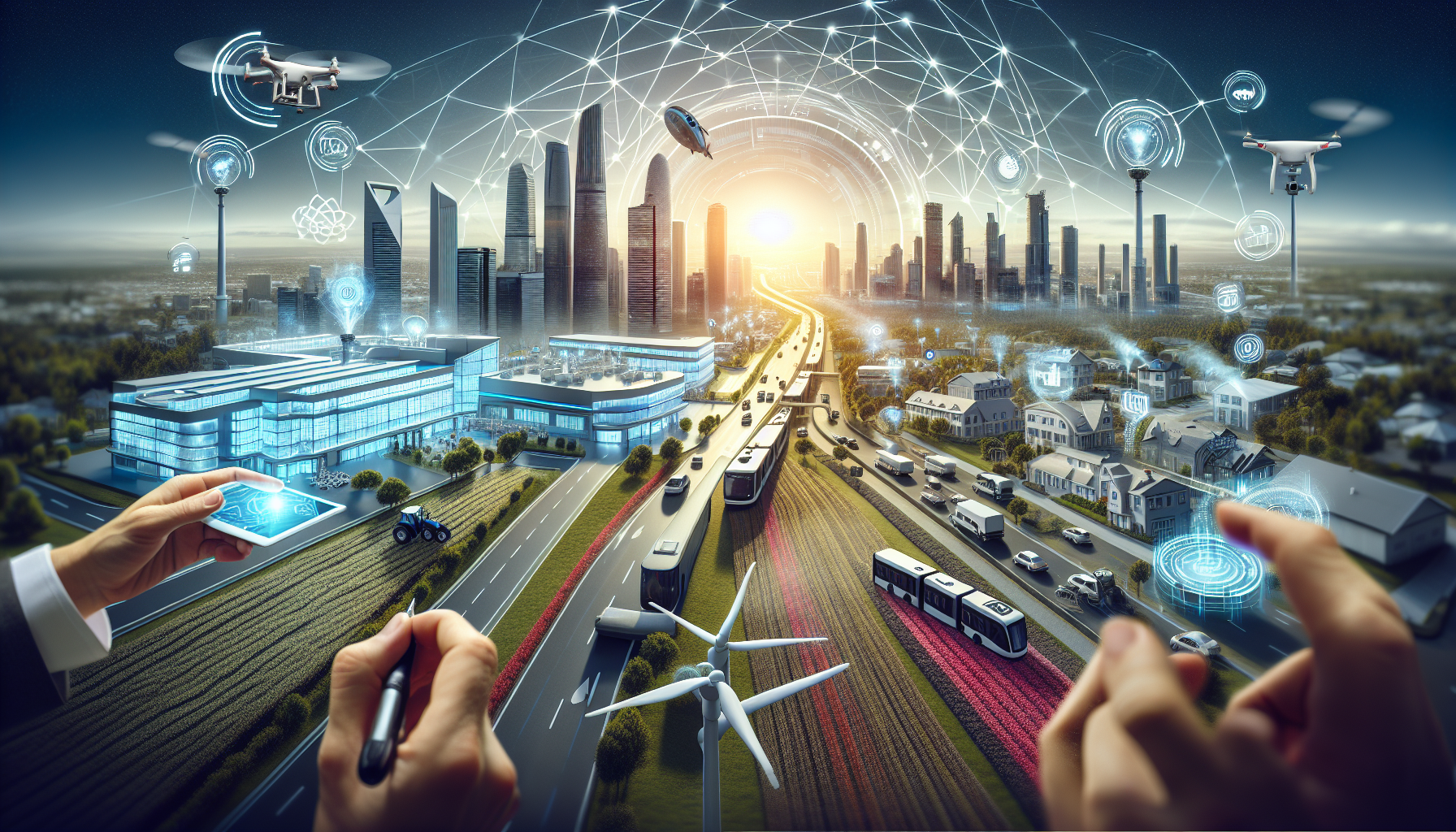Imagine a world where everything is interconnected, where everyday objects communicate and share information seamlessly. This is the promise of the Internet of Everything (IoE). But where exactly is IoE being used? From smart homes that enhance our daily routines to smart cities that optimize efficiency, IoE is revolutionizing industries and transforming the way we live. In this article, we will explore the various applications of IoE, from healthcare to transportation, and discover how this powerful technology is shaping our future.

Healthcare
Remote patient monitoring
Remote patient monitoring is a revolutionary application of the Internet of Things (IoT) in healthcare. With the help of connected devices and sensors, healthcare providers can remotely monitor patients’ vital signs, symptoms, and medication adherence. This enables healthcare professionals to provide timely interventions and personalized treatments without the need for patients to physically visit healthcare facilities. Remote patient monitoring not only improves the quality of care but also allows for efficient use of resources by reducing the number of hospital admissions and re-admissions.
Smart hospital management
Smart hospital management is another area where the Internet of Things plays a crucial role. By integrating various IoT devices and systems, hospitals can streamline their operations, enhance patient care, and improve efficiency. Sensors can be used to monitor medical equipment, track inventory levels, and even manage hospital alarms. Additionally, IoT-enabled patient tracking systems can help hospital staff quickly locate and assist patients, reducing wait times and enhancing overall patient experience.
Telemedicine
Telemedicine, fueled by the Internet of Things, is transforming the way healthcare is delivered. Through virtual consultations, patients can connect with healthcare professionals remotely, eliminating the need for physical visits and allowing for more convenient access to healthcare services. IoT devices, such as wearables and home monitoring systems, enable real-time health data collection, facilitating accurate diagnoses and personalized treatment plans. Telemedicine not only enhances healthcare accessibility but also improves patient outcomes by promoting continuous monitoring and reducing healthcare costs.
Transportation
Intelligent traffic management
Intelligent traffic management is a vital application of the Internet of Things in the transportation sector. By deploying smart sensors, cameras, and connectivity infrastructure, traffic authorities can collect real-time data on road conditions, traffic volumes, and congestion levels. This data can then be used to optimize traffic signal timings, manage traffic flow, and make informed decisions to improve overall transportation efficiency. Intelligent traffic management systems can significantly reduce travel times, decrease fuel consumption, and contribute to a greener environment.
Connected vehicles
Connected vehicles, enabled by the Internet of Things, are revolutionizing the automotive industry. By integrating vehicles with various IoT technologies, such as sensors, communication systems, and navigation devices, vehicles become smarter, more efficient, and safer. Connected vehicles allow for real-time monitoring of vehicle performance, enabling proactive maintenance and reducing the likelihood of breakdowns. Moreover, these vehicles can communicate with each other and with infrastructure, facilitating the implementation of advanced safety systems, such as collision avoidance and adaptive cruise control.
Fleet management
Fleet management is a critical aspect of transportation logistics, and the Internet of Things is playing a significant role in transforming how fleets are managed. IoT-enabled sensors and tracking devices allow fleet operators to monitor vehicle location, fuel consumption, driver behavior, and overall fleet performance in real-time. This data provides valuable insights that can be used to optimize routes, reduce fuel costs, improve driver safety, and enhance overall fleet efficiency. Fleet management systems powered by IoT technologies streamline operations, maximize productivity, and ultimately lead to cost savings for businesses.
Smart Cities
Urban infrastructure management
Smart city initiatives leverage the Internet of Things to improve the management of urban infrastructure. By deploying IoT sensors and devices throughout cities, authorities can gather data on various aspects of infrastructure, including transportation, energy usage, and waste management. This data can then be analyzed to optimize resource allocation, identify areas for improvement, and make informed decisions to enhance the overall livability of cities. Urban infrastructure management enabled by IoT technologies enables cities to become more sustainable, efficient, and responsive to the needs of residents.
Energy management
Energy management is a key component of building sustainable cities, and the Internet of Things plays a crucial role in this area. IoT devices can be deployed to monitor and control energy consumption in buildings, street lighting, and other infrastructure. Real-time data on energy consumption allows for intelligent energy usage, optimizing energy distribution and minimizing waste. Additionally, IoT-enabled energy management systems can facilitate renewable energy integration by monitoring renewable energy generation and developing strategies to maximize its utilization.
Waste management
Waste management is a significant challenge in urban environments, and the Internet of Things offers solutions to make waste management more efficient and sustainable. IoT sensors and connected waste bins can provide real-time data on fill levels, allowing waste collection services to optimize routes, reduce collection frequency, and minimize environmental impact. Furthermore, IoT-based waste management systems enable the implementation of smart recycling initiatives by automatically sorting and segregating different types of waste, promoting recycling and reducing landfill waste.
Manufacturing
Industrial automation
Industrial automation powered by the Internet of Things is transforming the manufacturing sector, enhancing productivity, efficiency, and safety. IoT sensors and connected devices can monitor and control various processes, allowing for real-time data collection and analysis. This enables predictive maintenance, reducing downtime and optimizing production schedules. Additionally, industrial automation facilitates the integration of robotics, AI, and machine learning technologies to automate repetitive tasks, improve precision, and enhance overall manufacturing operations.
Supply chain management
The Internet of Things is revolutionizing supply chain management by enabling real-time tracking and monitoring of goods throughout the entire supply and distribution process. IoT devices, such as RFID tags and sensors, can provide valuable data on inventory levels, product location, and temperature conditions. This data allows for better inventory management, minimizes stock-outs and overstocks, and enhances supply chain visibility. With IoT-powered supply chain management systems, businesses can streamline operations, reduce costs, and deliver products to customers more efficiently.
Predictive maintenance
Predictive maintenance is a critical application of the Internet of Things in the manufacturing industry. By using IoT sensors to continuously monitor equipment performance and collect data on factors such as temperature, vibration, and energy consumption, manufacturers can predict when maintenance is required before a breakdown occurs. Predictive maintenance helps minimize unplanned downtime, reduce maintenance costs, and optimize equipment lifespan. Ultimately, this improves operational efficiency and enables manufacturers to deliver products more reliably and consistently.

Retail
Inventory management
Inventory management is a fundamental aspect of the retail industry, and the Internet of Things is revolutionizing how retailers manage their inventory. RFID tags, barcode scanners, and IoT sensors can provide real-time visibility into inventory levels, supply chain movements, and product availability. This allows retailers to optimize stock levels, streamline replenishment processes, and reduce the likelihood of stockouts or overstocking. IoT-enabled inventory management systems improve accuracy, efficiency, and reduce costs associated with manual inventory counting and stock control.
Smart shelves and checkout
Smart shelves and checkout systems are transforming the retail experience for both customers and retailers. IoT-enabled smart shelves can use sensors to detect when items are removed or returned, providing real-time inventory updates and enabling automatic replenishment processes. Additionally, IoT-powered checkout systems, such as self-checkout kiosks, streamline the payment process, reduce checkout queues, and enhance customer convenience. Smart shelves and checkout systems improve the overall shopping experience, increase operational efficiency, and provide retailers with valuable insights into consumer behavior and product trends.
Personalized marketing
The Internet of Things enables retailers to deliver personalized marketing experiences to their customers. By leveraging IoT technologies, such as beacons and mobile applications, retailers can collect valuable data on customer preferences, behaviors, and location. This data enables the delivery of targeted and personalized advertisements, promotions, and recommendations to customers in real-time. Personalized marketing powered by the IoT enhances customer engagement, increases sales, and builds stronger customer loyalty by tailoring shopping experiences to individual preferences.
Agriculture
Precision farming
Precision farming, enabled by the Internet of Things, is revolutionizing the agriculture industry. IoT sensors and devices can monitor various environmental factors, such as soil moisture, temperature, and humidity, allowing farmers to make data-driven decisions regarding irrigation, fertilization, and crop protection. This precision agriculture approach optimizes resource usage, reduces environmental impact, and improves crop yields. Additionally, IoT-enabled precision farming systems enable farmers to remotely monitor and manage their crops, reducing labor requirements and increasing operational efficiency.
Livestock monitoring
Livestock monitoring is an essential application of the Internet of Things in the agriculture sector. IoT sensors and wearable devices can be attached to animals to collect data on their health, behavior, and location. This real-time monitoring enables early detection of health issues, improves animal welfare, and enhances overall livestock management. Additionally, IoT technology allows farmers to remotely monitor and track herds, ensuring the safety and security of their livestock. Livestock monitoring systems powered by IoT technologies increase productivity, reduce losses, and improve the quality of animal products.
Crop monitoring
Crop monitoring is critical for maximizing agricultural productivity, and the Internet of Things provides valuable tools for monitoring and managing crops. IoT sensors and satellite imagery can provide real-time data on crop health, growth, and environmental conditions. This data enables farmers to optimize irrigation, crop protection, and fertilization, ensuring optimal growth and minimizing resource wastage. Furthermore, IoT-based crop monitoring systems can facilitate early detection and mitigation of pests and diseases, preventing crop losses and reducing reliance on chemical treatments. Crop monitoring systems powered by the Internet of Things enhance yield, reduce environmental impact, and improve the sustainability of agricultural practices.
Energy
Smart grid management
The Internet of Things is revolutionizing the management of energy distribution networks through smart grid technology. IoT sensors and devices can gather real-time data on energy consumption, grid performance, and power quality. This allows utility companies to optimize energy distribution, detect and address faults, and manage peak demand more efficiently. Smart grid management enabled by the Internet of Things improves energy reliability, reduces transmission losses, and enables the integration of renewable energy sources into the grid, leading to a more sustainable and resilient energy system.
Renewable energy integration
Renewable energy integration is a crucial aspect of transitioning to a cleaner and more sustainable energy future, and the Internet of Things plays a significant role in this area. IoT devices can monitor and control renewable energy generation, storage, and distribution, optimizing energy flows and maximizing utilization. Real-time data on energy production and usage enables grid operators to efficiently manage the integration of renewable energy into the grid, balancing supply and demand. The Internet of Things empowers the effective integration of renewable energy sources, reduces dependency on fossil fuels, and promotes a greener energy ecosystem.
Energy efficiency
Improving energy efficiency is a top priority for combating climate change, and the Internet of Things offers solutions to achieve this goal. IoT-enabled energy management systems can monitor and control energy consumption in buildings, industrial facilities, and homes, identifying inefficiencies and providing insights for optimization. By analyzing real-time data on energy usage and equipment performance, energy efficiency can be enhanced through predictive maintenance, smart HVAC systems, and intelligent lighting controls. Energy efficiency enabled by the Internet of Things reduces carbon emissions, lowers energy costs, and ensures the sustainable use of resources.
Education
Smart classrooms
The integration of the Internet of Things in education has led to the development of smart classrooms, where technology enhances teaching and learning experiences. IoT devices, such as interactive whiteboards, tablets, and wearables, facilitate interactive and personalized learning, promoting student engagement and collaboration. IoT sensors and systems can monitor classroom conditions, such as temperature and air quality, ensuring a conducive learning environment. Smart classrooms powered by the Internet of Things improve educational outcomes, enable dynamic teaching methodologies, and prepare students for the digital future.
E-learning platforms
E-learning platforms are transforming the way education is delivered, and the Internet of Things plays a crucial role in making these platforms more effective and engaging. IoT devices, such as smart devices, wearables, and virtual reality tools, enhance the accessibility and interactivity of online learning materials. IoT sensors can track student progress and behavior, enabling personalized learning experiences tailored to individual needs. E-learning platforms powered by IoT technologies provide flexibility, foster independent learning, and enable the seamless integration of multimedia and interactive content.
Student progress tracking
The Internet of Things enables comprehensive student progress tracking, enabling educators and parents to monitor and support students’ academic development. IoT devices and systems can collect real-time data on students’ learning activities, engagement levels, and performance. This data can then be analyzed to provide insights into students’ strengths, weaknesses, and learning preferences, facilitating personalized interventions and tailored learning plans. By tracking student progress through IoT-powered systems, educators can provide timely feedback, identify areas for improvement, and ensure that every student receives the support they need to succeed.
Finance
Secure financial transactions
Security is of utmost importance in the finance industry, and the Internet of Things provides solutions to enhance the security of financial transactions. IoT technologies, such as biometric authentication, tokenization, and encryption, can ensure the confidentiality and integrity of sensitive financial data. IoT sensors and devices can be used to monitor and detect unauthorized activities, such as suspicious transactions or physical breaches. By integrating IoT security measures, financial institutions can safeguard customer information, reduce the risk of fraud, and enhance trust in financial services.
Fraud detection
The Internet of Things enables advanced fraud detection systems in the finance industry. IoT devices can monitor and analyze multiple data sources in real-time, including transaction data, user behavior, and device location. By employing AI algorithms and machine learning techniques, anomalies and patterns indicative of fraudulent activities can be identified, enabling rapid response and prevention of financial fraud. IoT-powered fraud detection systems enhance the security of financial transactions, protect customers’ assets, and minimize financial losses.
Risk analysis
Risk analysis is a vital aspect of financial decision-making, and the Internet of Things offers valuable tools for gathering and analyzing relevant data. IoT devices and sensors can provide real-time data on various risk factors, such as market trends, weather conditions, or supply chain disruptions. This data enables financial institutions to make informed risk assessments and develop strategies to mitigate potential threats. IoT-powered risk analysis enhances the accuracy and timeliness of decision-making, improves risk management practices, and ultimately leads to more prudent and successful financial operations.
Security
Surveillance systems
Surveillance systems powered by the Internet of Things improve security and safety in various environments. IoT-enabled cameras, sensors, and facial recognition technologies can monitor and track individuals, identify suspicious activities, and detect potential threats in real-time. By analyzing data collected from multiple sources, such as video feeds, access logs, and environmental sensors, surveillance systems can provide a comprehensive view of security situations, enabling timely response and intervention. IoT-powered surveillance systems enhance public safety, protect assets, and deter criminal activities.
Access control
Access control systems play a vital role in ensuring the security and integrity of physical spaces, and the Internet of Things enhances access control capabilities. IoT sensors, biometric authentication, and smart cards can be integrated into access control systems to provide secure and convenient access to restricted areas. Real-time monitoring and analysis of access data enable proactive identification of unauthorized entries or suspicious activities, allowing for immediate response and prevention of security breaches. IoT-enabled access control systems enhance security measures, streamline access management processes, and protect individuals and assets.
Cybersecurity measures
Protecting digital assets from cyber threats is a critical concern in the interconnected world, and the Internet of Things introduces new cybersecurity challenges. However, IoT technologies can also be leveraged to enhance cybersecurity measures. IoT security solutions, such as secure communication protocols, encryption algorithms, and intrusion detection systems, can be implemented to safeguard IoT devices and networks. Additionally, AI and machine learning technologies can analyze vast amounts of data to identify potential cybersecurity vulnerabilities, detect anomalies, and respond to cyber attacks in real-time. By incorporating robust cybersecurity measures, the Internet of Things can enable safe and secure digital interactions and transactions.
In conclusion, the Internet of Things is a transformative force that is revolutionizing various sectors, ranging from healthcare and transportation to smart cities and education. By leveraging IoT technologies, businesses and industries can enhance efficiency, improve decision-making, and deliver innovative solutions to address complex challenges. From remote patient monitoring in healthcare to precision farming in agriculture, and from smart grid management in the energy sector to personalized marketing in retail, the Internet of Things is reshaping industries and enabling the creation of smarter, more connected and sustainable ecosystems.
